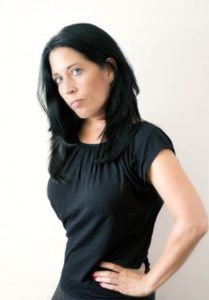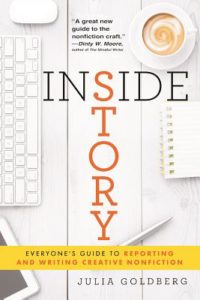Tags
Related Posts
Share This
Julia Goldberg Reading at Collected Works

Julia Goldberg is a faculty member at Santa Fe University of Art and Design. Photo by Jessica Preston
Julia Goldberg, Creative Writing and Literature faculty at Santa Fe University of Art and Design, will be reading from her new book Inside Story at Collected Works Bookstore and Coffee House at 6 p.m. on Saturday, April 8, with a Q&A with author Robert Wilder to follow. Inside Story is an all-encompassing guide to writing creative nonfiction in its many forms. Creative nonfiction can cover many things, from reported journalism to memoir, and Inside Story gives readers an easy-to-read source for anyone wanting to either start exploring nonfiction writing or polish their skills. Prior to teaching at SFUAD, Goldberg spent 11 years as the editor of the Santa Fe Reporter and, in the past, was a morning radio host at KVSF, 101.5 FM.
Each chapter covers different aspects of nonfiction: reportage, arts writing, interviewing, voice, sources, structures, etc. There are also sections titled “Prompts and Practice,” which give the reader the opportunity to put what they’ve just read to good use. Goldberg includes essays and other additional readings that work as strong examples of successful creative nonfiction. Her familiar and authentic voice throughout the book makes it both playful and informative. There’s no doubt that those who attend her reading will leave Collected Works, crack open her book and feel as though the reading never ended.
Days before her reading at Collected Works, Julia Goldberg sat down with Jackalope Magazine to talk about her experiences putting her book together, teaching and nonfiction in general.
Jackalope Magazine: What are some differences between craft books for creative nonfiction and craft books for fiction/poetry?
Julia Goldberg: I think all craft books, to some degree, aim to demystify writing. And maybe that upsets people, because I think to some degree we think, ‘Oh it’s like magic! Oh, the muse has visited me!’ But I think all forms of writing require understanding of the technicalities and craft…And I think, in the case of nonfiction, I had someone who looked at the book say to me, ‘This chapter on interviewing is really helpful to me, because I want to do this kind of thing and I wouldn’t even know how to get started’; because if you haven’t done something, it seems really hard to do. So I tried to incorporate a lot of the things that I’ve taught here [at SFUAD] as well as a lot of the things that I’ve learned on the job, and tried to demystify them. Because I do think that everyone should feel like they have access to tell, not just their own stories, but stories of the world in which they live. That’s the way we kind of get to know about the world.
What made you want to teach nonfiction?
I think in the last two years of being editor of the Reporter, I served on the board of this national journalism organization called the Association of Alternative News Media. I was on the board as the editorial chair and I got to do some of the conference and workshop programming, things like that. And I started to just feel a little bit like I enjoy having the chance to think about journalism and think about writing and sometimes work in one-on-one situations. I wanted the opportunity to spend a little bit more time thinking about process and not just about, get it out get it out get it out.
When it came to interviewing people for this book, how did it go?
Yeah, there was a lot of reporting that went into this book on reporting. And it was really fun because I’ve met so many really cool reporters and I’ve worked with so many cool writers and editors and it was fun having those conversations…I like the inside baseball, I like talking about writing, I like talking about reporting. So I was having the time of my life just calling up all these different writers and editors and journalists that I knew and just being like, Can we talk about beat reporting? Let’s talk about this. And it was only when I was sort of done doing all the interviewing, I think I’d given myself a couple months to just do interviewing, then I was looking at the file of all the recorded interviews and I was like, ‘What have you done? You have like 30,000 hours of interviews.’

Julia Goldberg’s book, Inside Story, a guide to writing nonfiction. Leaf Storm Press, 2017.
How long was the interview process?
That’s an incredibly good question. I have no idea. I had a really short turnaround deadline, and I was like ‘No problem!’ Because I’m just so used to writing on deadline I thought, well I can do anything just give me a deadline. I didn’t really anticipate how psychotic it was going to be to try to make the deadline I had. I mean, I did the vast majority of the writing last summer. The vast majority of the interviews were done in the few months before that. But then I had a lot of clean up work and a lot of editing and I wasn’t done in the summer. It was really barebones. I had a pretty severe underestimation of how long things were going to take me. Which has never happened to me before. I was humbled. I haven’t missed a deadline since college.
What differences did you notice between publishing a piece in a journal or newspaper and publishing a full-length book?
I described it to someone who’s a working journalist. I said it’s like, normally you’re on deadline, you have a three, five-thousand-word story, and if you spend eight hours writing, you’re kind of done. You might have some revisions or some edits, but you’ve just spent eight hours at your computer and you’re done. And then this was like you spend eight hours at your computer and you’ve done nothing. And every day you spend eight hours at your computer and you’re like ‘I’m getting nowhere.’ It was kind of shocking to me.
In your book, you mention how changing voice is important, and changing voice for specific things. When you first had to do that, what did it feel like?
I mean I–and I think I talk about this in the book–I really am attracted to the idea of writing as a persona and a performance and not feeling like there’s just one Julia Goldberg voice and everything sounds like Julia Goldberg. I like the idea that I can also write in an academic voice or that I can write in a more mournful and sad tone, as appropriate. Or in this case, the book is sort of light-hearted. I want to feel that I’m multidimensional as a writer and a human being and not just like, ‘Here’s the jokes, folks!’ I think that there’s just a lot of confusion where people are like, ‘Oh I only have one authentic voice.’ To me that’s like saying I only have one way that I am in the world, and we have so many different ways that we are in the world.
On the cover of the book it says, “For students and teachers, citizen journalists, bloggers, and working writers.” What do you hope they get from reading this?
I think that the best thing that books like this can do is give people resources and ideas and information, but also cultivate an excitement to just do their own work…Sometimes I really feel like writing and sometimes I have to do things to make myself feel like writing. I will sometimes read writers that I love talking about the craft or talking about the process, and it excites me because I’m interested in writing, not just as something I do, but as something to talk about. Obviously. Writing professor finds writing interesting, that’s like an Onion title.
This interview has been condensed and edited for style and clarity.






 Jackalope Magazine is the student magazine of Santa Fe University of Art and Design. Building on the interdisciplinary nature of our education, we aim to showcase the talent of our university and character of our city.
Jackalope Magazine is the student magazine of Santa Fe University of Art and Design. Building on the interdisciplinary nature of our education, we aim to showcase the talent of our university and character of our city.
Recent Comments